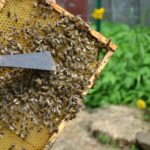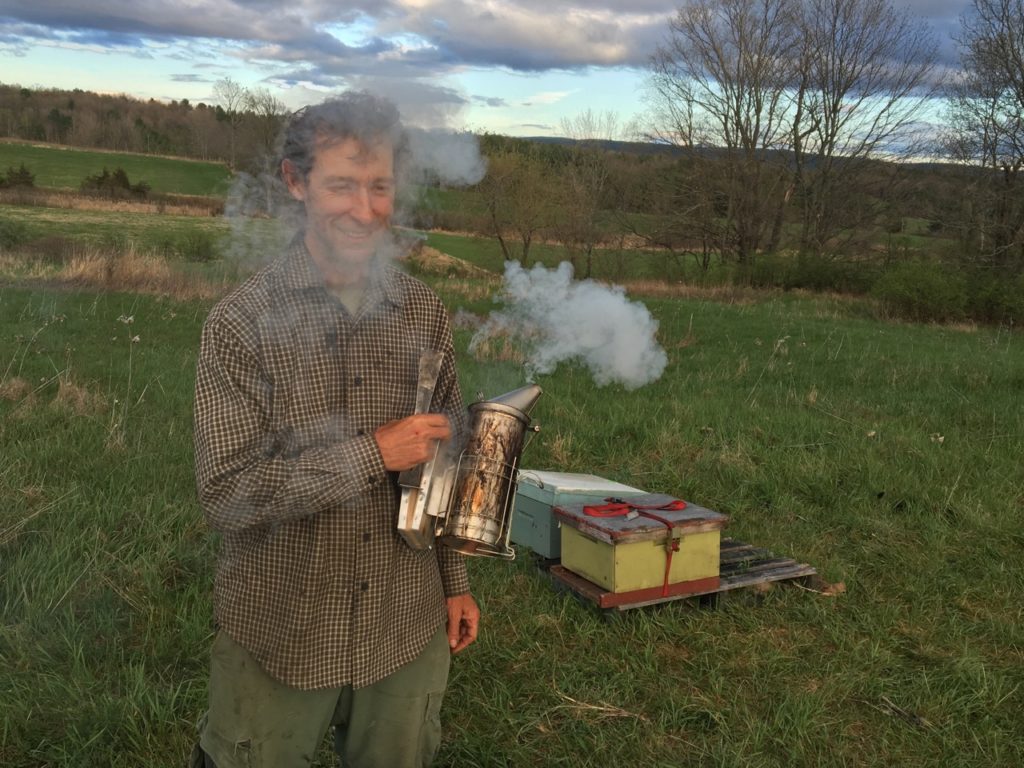Honey bees on the farm will pollinate our flowers. Todd began a relationship with honey bees over 50 years when he and his brother Tom, 9 years old, bought their first hive for their family farm. They were enchanted by how industrious the bees were, giving them honey, pollen, propolis and beeswax for candles and salve. Around 40% of what is eaten is pollinated by insects, this to a great degree by honey bees. Because there are so few nectar & pollen plants on Thornhill Farm, we are planting these plants for the bees. We know the soil is worn out on the farm because our honey bees make so little honey. This is why we have pigs. When the forest is cleared, we do not burn the wood that is left behind, but chip it and mix these wood chips with manure and fungus mycelium to make piles of compost to improve the soil. Last summer we grew peas and oats as a green manure crop, and the pea flowers gave voluminous amounts of nectar to the honey bees and pollinating insects.
Health & the Hive: A Beekeeper’s Journey
 A Jan Cannon Film that explores the importance of honeybees in our lives through the seasons of Honey Gardens Apiaries, Todd and the team. Topics addressed in the film include pollination, queen breeding, disease control, bee venom therapy, organic agriculture and honey-based plant medicine. 53 minute dvd. $10 + $4 (shipping).
A Jan Cannon Film that explores the importance of honeybees in our lives through the seasons of Honey Gardens Apiaries, Todd and the team. Topics addressed in the film include pollination, queen breeding, disease control, bee venom therapy, organic agriculture and honey-based plant medicine. 53 minute dvd. $10 + $4 (shipping).
to order, send a check to: 198 Taylor Road, Greensboro Bend, Vermont 05842
writings & images about the honey bees of Thornhill Farm
- Tim McFarline, McFarline Apiaries, Benson, Vermont June 3, 2016

Tim McFarline, McFarline Apiaries, Benson, Vermont. Tim raises queen bees organically from survivors and sells colonies of bees each Spring. We worked together for six years. May 2016.
Live from the Hive by Annie Watson – Winter 1997 to July 2015 archives
- Live from the Hive: September 2014“Goldenrod” by Annie Watson, Thistle Hill Studio As I walk in the garden, a pungent essence wafts across the back yard. This is goldenrod honey, being made in the beehives. September is the month of the goldenrod bloom, characterized by a spicy fragrance coming from the flowers and a heavy, rich, yeasty aroma emanating from the ...
- Live from the Hive: August 2014“Burdock, an essential plant” by Annie Watson, Thistle Hill Studio The crickets are singing nonstop…We’ll be heading to Addison County Field Days, Vermont’s big agricultural fair, this week…Blackberries are ripe. Most days are still very warm, but there’s a chill in the air of an evening. Summer is winding down. For honey bees, the next six weeks ...
- Live from the Hive: July 2014“The Making of a Queen” by Annie Watson, Thistle Hill Studio In this picture you see a “queen cup” — an elongated cell, looking a bit like an ice cream cone, that contains a queen bee larva. The bees are making a new queen, which they do when the queen dies, is failing, or has left ...
- Live From the Hive: June 2014“Blackberry Bloom” by Annie Watson, Thistle Hill Studio One of my favorite events of the year is the blossoming of the wild blackberries (rubus alligheniensis). You can tell where the plants are from the rich spicy, woody fragrance that the unopened flower buds give off in April and May, heralding the coming of the flowers. It’s ...
- Live From the Hive: May 2014“The Gift of the Dandelion” by Annie Watson, Thistle Hill Studio May is such an important and busy month for the honey bees. The colony is rearing brood, and many plants are flowering, providing food for the growing population. Ground ivy and dandelions are everywhere. Dandelions are such an important food source for bees. Many people ...